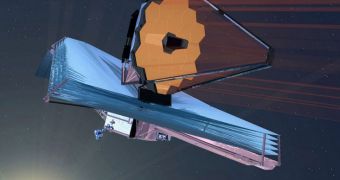Recently, experts at Northrop Grumman needed only four days to install a full-scale model of NASA's future James Webb Space Telescope (JWST), in New York.
Unlike a model, designing, developing, building and commissioning a “real” space telescope takes years of hard work, until all systems are integrated and working properly.
The amount of effort naturally increases in direct proportion with the complexity of the overall project, which is precisely why the feat Northrop engineers achieved is so amazing.
They managed to put together a full-scale model of the JWST in much less than a week, even though the observatory, designated to be the successor of the Hubble Space Telescope – is impressively complex.
The machine was on display in Battery Park between June 1-6, during the 2010 World Science Festival, Space Fellowship reports.
It was installed in public so that everyone could catch a glimpse at precisely how complex and difficult-to-build the machinery is. Northrop Grumman is the prime contractor for the project.
Even as a model, the JWST was impressive in size – 80 feet long, 40 feet wide and 40 feet tall. It weighted in at an estimated 12,000 pounds (5,440 kilograms).
Astronomers say that, while the JWST model may have been indeed impressive, it amounts to nothing when it comes to comparing it to the real deal.
NASA's next main observatory will need to be able to withstand harsh temperature swings, which may sometimes amount to as much as 200 degrees Fahrenheit within a single day.
Additionally, the instrument will also need to be able to withstand micro-meteor impacts, and as well as intense exposure to solar radiation. Once out of Earth's atmosphere, it will have no other protective layers than the one it carries.
Moreover, the JWST will need to endure the harsh conditions of a rocket launch, when it will pull many Gs, and be subjected to violent trepidations.
The instrument needs to be constructed in such a manner that all of its sensitive, high-tech instruments can make it to orbit in one piece.
This is very difficult to do, considering that the cameras and mirrors that will go on the JWST will be oriented on sensitivity, and not strength.

 14 DAY TRIAL //
14 DAY TRIAL //